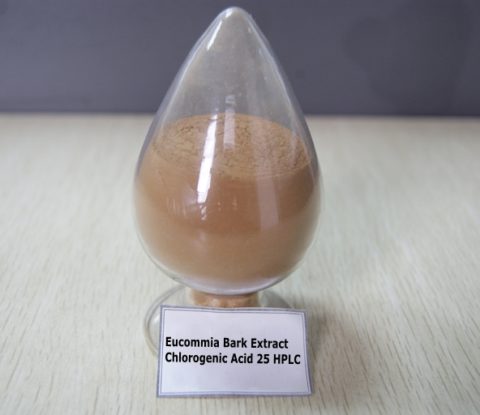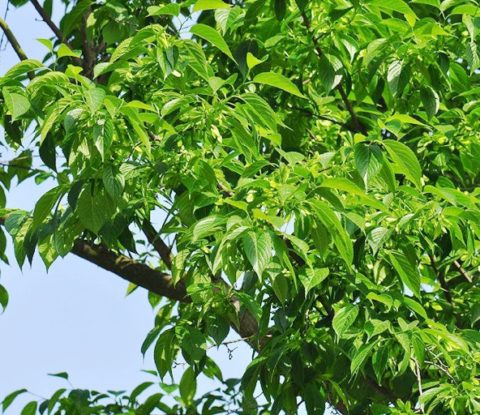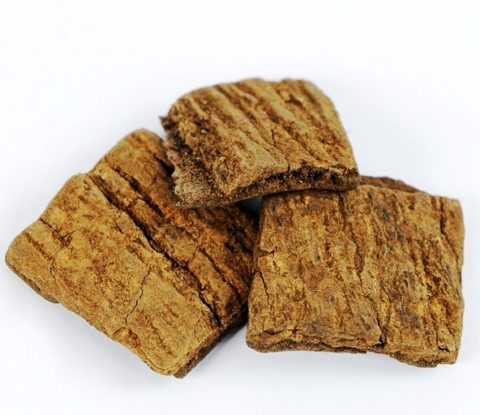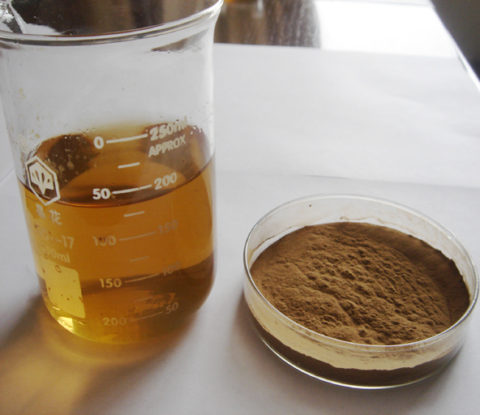
Eucommia Bark Extract
Eucommia Bark/Du Zhong/Cortex Eucommiae Extract Powder
【Latin Name】: Eucommia ulmoides Oliv.
【Plant part used】: Bark
【Active Ingredient】: Chlorogenic Acid
【Specification】: 5%-99% Chlorogenic Acid by HPLC; 10:1, 20:1 by TLC
【Test Method】: HPLC/TLC
【Extract Method】: Grain Alcohol/Water
【Appearance】: Light brownish to offwhite fine powder
【Molecular Formula】: C16H18O9(Chlorogenic Acid)
【Molecular Weight】: 354.30(Chlorogenic Acid)
【CAS No.】: 327-97-9(Chlorogenic Acid)
【Benefits】: Support vitality and strength, lower blood pressure
Brief Introduction
More commonly referred to as the Gutta-Percha or Rubber Bark tree or the Traditional Chinese Medicine known as Du Zhong, Eucommia ulmoides (of the Eucommiaceae family) is a medicinal plant where both the leaves and the bark have been used for the purposes of hastening relief of back pain, to increase stamina and recover from fatigue, and to make bones and muscles stronger while promoting longevity and fertility. When used in Kampo medicine, it goes by the name of Tochu and the leaves are sometimes used to brew Tochu tea. This plant also has some usage as a tree that can produce rubber due to the trans-polyisoprene compounds it can produce, which is why the tree also has the common name of ‘Rubber Bark Tree’.
Chemical Composition
The bark (ethanolic extract unless otherwise stated) has been noted to include:
–Geniposidic acid (0.925% of bark) and its aglycone geniposide (0.488%) and genipin (0.214%)
–Trans-polyisoprene compounds, used mostly in rubber making
–Lignans (+)-pinoresinol-4,4′-di-O-β-D-glucopyranoside (pinoresinol diglucoside), (+)-pinoresinol-4-O-β-D-glucopyranosyl(1→6)-β-D-glucopyranoside, (+)-medioresinol-4,4′-di-O-β-D-glucopyranoside, (+)-syringaresinol-4,4′-di-O- β-D-glucopyranoside, (−)-olivil-4′-O-β-D-glucopyranoside, (−)-olivil-4-O-β-D- glucopyranoside, and (+)-pinoresinol-4-O-β-D-glucopyranoside with both syringaresinol diglycoside (0.214%) and (+)-pinoresinol-di-β-d-glucopyranoside (0.991%) being quantified
–Licoagroside F (28.78+/-0.81μg/g)
–The flavonoids Baicalein (0.28+/-0.010μg/g), wogonin (0.20+/-0.0027μg/g), and oroxylin A (0.09+/-0.0040μg/g)
–Caprylic acid (involved in androgen signalling and also found in Coconut Oil)
–Triterpenoids
–Chlorogenic acid (0.302%)
Whereas the leaves of Eucommia ulmoides include:
–The irioid glycosides Geniposidic acid (10.1-17.4mg/g), Aucubin (6.5-19.7mg/g; geniposidic acid without the carboxylic acid group), and Asperuloside (13.7-27.8mg/g)
–Quercetin (0.27-0.62mg/g) as isoquercetin, rutin (7.6-14.3mg/g), and 3-O-sambubioside as well as 3-O-alpha-L-arabinopyranosyl-(1->2)-beta-D-glucopyranoside
–Kaempferol and astragalin (kaempferol 3-O-beta-D-glucopyranoside)
–Licoagroside F at 8.97+/-0.41μg/g
–Baicalein (0.23+/-0.002μg/g), Wogonin (0.19+/-0.0030μg/g), and Oroxylin A (0.04+/-0.0004μg/g)
–Lignans Syringaresinol di-O-Glc (275.53+/-0.99μg/g) and Pinoresinol di-O-Glc (384.15+/-19.67μg/g)
–Chlorogenic Acid (26.3-46.9mg/g)
–Ferulic and caffeic acid
Structurally, chlorogenic acid is the ester formed between caffeic acid and L-quinic acid. Isomers of chlorogenic acid include 4-O-caffeoylquinic acid (cryptochlorogenic acid or 4-CQA), 5-O-caffeoylquinic acid (neochlorogenic acid or 5-CQA). The epimer at position 1 has not yet been reported. Isomers containing two caffeic acid molecules are called isochlorogenic acid. It can be found in many plants like eucommia bark, honeysuckle, green coffee beans and so on. There are several isomers such as 3,4-dicaffeoylquinic acid and 3,5-dicaffeoylquinic acid Cynarine (1,5-dicaffeoylquinic acid) is an other isomer with two caffeic acid molecules.
Chlorogenic acid is an antioxidant and an inhibitor of the tumor promoting activity of phorbol esters. Chlorogenic acid and caffeic acid are antioxidants in vitro and might therefore contribute to the prevention of Type 2 Diabetes Mellitus and cardiovascular disease. It is claimed to have antiviral, antibacterial and antifungal effects with relatively low toxicity and side effects, alongside properties that do not lead to antimicrobial resistance. Potential uses are suggested in pharmaceuticals, foodstuffs, feed additives, and cosmetics.
Indications In TCM(Traditional Chinese Medicine)
1.Deficiency of liver and kidney, soreness and pain in lumbar and knees, atrophy-flaccidity and limpness of lower limbs
It is an important herb for soreness and pain in lumbar and knees, atrophy-flaccidity and limpness of lower limbs caused by deficiency of liver and kidney, because it can tonify liver and kidney, strengthen tendons and bones. It could be used singly or combined with other herbs to tonify liver and kidney, strengthen tendons and bones, for instance, it is used with Hu Tao Rou and Bu Gu Zhi in the formula Qing E Wan from He Ji Ju Fang. For wind-cold attacking for a long time, deficiency of liver and kidney, soreness and pain in lumbar and knees, difficulty in bending and stretching of limbs, atrophy-flaccidity and limpness of limbs, it is combined with herbs of dispelling wind-cold, tonifying liver and kidney, strengthening tendons and bones. For instance, it is used with Du Huo, Sang Ji Sheng, Shu Di Huang and Niu Xi in the formula Du Huo Ji Sheng Tang from Qian Jin Fang. In addition, it is indicated for impotence, seminal emission, spermatorrhea, enuresis and frequent urination due to kidney yang deficieny, but these symptoms are not its first indications, therefore, it needs to be combined with kidney yang-tonifying and essence-nourishing herbs, for instance, it is used with Fu Zi, Rou Gui and Shu Di Huang.
2.Threatened abortion, vaginal bleeding during pregnancy, habitual abortion due to liver and kidney deficiency
It is a common herb used for threatened abortion, vaginal bleeding during pregnancy, habitual abortion due to liver and kidney deficiency, insecurity of thoroughfare and conception vessels, because it can tonify liver and kidney, regulate and strengthen thoroughfare and conception vessels to prevent abortion. It could be used singly, or made into pill with Da Zao, or combined with herbs of tonifying liver and kidney, preventing abortion, tonifying qi, nourishing blood, for instance, it is used with Xu Duan, Tu Si Zi, and Sang Ji Sheng. For threatened abortion due to over-strain, it is combined with herbs to activate blood, nourish blood, prevent abortion, for instance, it is used with Dang Gui, Chuan Xiong, E Jiao, and Tu Si Zi.
Besides, it has good action of depressing blood pressure, and is commonly used for hypertension in modern clinic. It is very indicated for hypertension of liver and kidney deficiency type, used singly or in combinations, because it can tonify liver and kidney.
Modern Researches on Pharmacological Benefits
1.Cardiovascular Health
Blood Pressure
Mechanistically, eucommia ulmoides appears to possess beta-blocking potential as assessed by a lipolysis assay with isoproterenol(Greenway F, et al A clinical trial testing the safety and efficacy of a standardized Eucommia ulmoides Oliver bark extract to treat hypertension .Altern Med Rev. (2011)).
Eucommia ulmoides bark can also cause vasorelaxation in a concentration dependent manner in a way that is fully dependent on Nitric Oxide and thought to be related to potassium channels(Kwan CY, et alEndothelium-dependent vasorelaxant effects of the aqueous extracts of the Eucommia ulmoides Oliv. leaf and bark: implications on their antihypertensive action . Vascul Pharmacol. (2003)).
Eucommia ulmoides appears to have antihypertensive effects due to its activating effects on the parasympathetic nervous system and can work in a dose-dependent manner in spontaneously hypertensive rats. In fructose overfed rats that develop insulin resistance and hypertension, 500-1000mg/kg of eucommia ulmoides can reduce blood pressure in a dose dependent manner but cannot completely normalize it(Lang C, et al Effect of Eucommia ulmoides on systolic blood pressure in the spontaneous hypertensive rat . Am J Chin Med. (2005)).
In prehypertensive humans, while supplementation of 500mg eucommia ulmoides (8% pinoresinol) daily for eight weeks only caused marginal reductions in blood pressure that faded with time a higher dose (1,000mg thrice daily) for two weeks has resulted in a reduction in both systolic and diastolic blood pressure by 7.5/3.9mmHg(Greenway F, et al A clinical trial testing the safety and efficacy of a standardized Eucommia ulmoides Oliver bark extract to treat hypertension .Altern Med Rev. (2011)).
2.Interactions with Glucose Metabolism
Ingestion of eucommia ulmoides daily for 90 days in rats appears to reduce the expression of the GLUT4 transporter in rats given a high fat diet, yet increased expression in rats on a normal diet (not obesogenic) and increased expression in skeletal muscle(Fujikawa T, et al Chronic administration of Eucommia leaf stimulates metabolic function of rats across several organs . Br J Nutr. (2010)).
In fructose drinking rats (a research model for fatty liver) given 500-1000mg/kg of eucommia ulmoides leaf extract over four weeks, the supplementation was able to fully normalize the changes in insulin and insulin sensitivity (HOMA-IR) without affecting blood glucose which was unaffected by fructose treatment initially(Jin X, et al Ameliorative effect of Eucommia ulmoides Oliv. leaves extract (ELE) on insulin resistance and abnormal perivascular innervation in fructose-drinking rats . J Ethnopharmacol. (2010)).
In streptozotocin-induced diabetic mice given eucommia ulmoides orally for four weeks (1,400mg/kg) was able to reduce blood glucose and normalize oxidative parameters such as SOD and MDA(He K, et alEvaluation of antidiabetic potential of selected traditional Chinese medicines in STZ-induced diabetic mice . J Ethnopharmacol. (2011)).
3. Fat Mass and Obesity
1). Mechanisms
Mechanistically, it has been noted that ingestion of Eucommia ulmoides is associated with increases in protein content of some intermediates of energy metabolism (isocitrate dehydrogenase 3, citrate synthase, pyruvate kinase, GLUT4, and H+ transporting mitochondrial F1 complex) and in rat liver increases in the activity of genes involved in fat oxidation has been noted in the range of 1.21-1.88 fold (300-1,600mg/kg leaf extract intake) which is thought to explain the increases in fat oxidation seen in the liver. The increase was noted on the rate-limiting stages of β-oxidation (Cpt1a, Acox1, and Acadvl), α-Oxidation, and ω-oxidation (Cyp4a1)( Kobayashi Y, et al Facilitative effects of Eucommia ulmoides on fatty acid oxidation in hypertriglyceridaemic rats . J Sci Food Agric. (2012)).
Differential effects have been noted on UCPs, with an increase in UCP3 seen in normal rats and an increase in UCP2 seen in high fat fed rats, and PPARγ mRNA has been found to be increased. The aforementioned genetic changes in liver enzymes also appear to be targets of PPARα and PPARδ, suggesting they may play a role(Fujikawa T, et al Chronic administration of Eucommia leaf stimulates metabolic function of rats across several organs . Br J Nutr. (2010)).
It is hypothesized that the above changes are due in part to geniposide and geniposidic acid as well as their aglycone (genipin) as they consist of most of the plant’s phytochemicals by weight and since geniposide has shown lipid reducing properties in isolation.
A study in anaethesized rats given an intraduodenal injection of eucommia ulmoides (1-5mg or 4-20mg/kg) noted an increase in sympathetic nerve activity in both white and brown adipose tissue, and in concious rats there was an increase in plasma fatty acids (154.5-156.6% at 1-5mg of the leaf extract) and body temperature(Horii Y, et al Effects of Eucommia leaf extracts on autonomic nerves, body temperature, lipolysis, food intake, and body weight . Neurosci Lett. (2010)).
At least one study, in assessing its mechanisms on blood pressure, has found beta-blocking properties in human fat cells able to reduce the effects of isoproterenol(Greenway F, et al A clinical trial testing the safety and efficacy of a standardized Eucommia ulmoides Oliver bark extract to treat hypertension .Altern Med Rev. (2011)). This suggests thateucommia ulmoides can suppress the effects of fat burners that signal via these receptors, namelyEphedrine or Synephrine.
2). Interventions
In mice given a high fat diet with 3% or 9% of either the leaf powder or water extract of eucommia ulmoides (corresponds to human doses of 0.99g and 2.35g respectively), the weight gain observed is abolished over 90 days of ingestion. In normal mice on a normal diet, the addition of 9%eucommia ulmoides is associated with a nonsignificant trend to lose body weight (12%) and a significant reduction in triglycerides and NEFA with an increase in adiponectin, and the high fat and normal diet groups given 9% were similar weights at the end of the trial(Fujikawa T, et al Chronic administration of Eucommia leaf stimulates metabolic function of rats across several organs . Br J Nutr. (2010)). The leaf powder and the water extract from the leaves are comparable in potency and other studies tested have noted a failure for high doses (3-6g/kg) to affect body mass over 35 days in rats (despite a reduction in white adipose tissue mass) and a failure for low doses (15.5mg daily) to reduce body mass in hamsters. One study comparing 3% leaf extract against 10% found only the latter effective at reducing body weight, although the degree of fat loss was less drastic and partially confounded with a reduction in food intake(Horii Y, et al Effects of Eucommia leaf extracts on autonomic nerves, body temperature, lipolysis, food intake, and body weight . Neurosci Lett. (2010)).
In osteoporotic mice, 5% of the diet as the water extract of eucomia ulmoides leaves is able to attenuate the rate of fat gain(Zhang W, et al Eucommia leaf extract (ELE) prevents OVX-induced osteoporosis and obesity in rats . Am J Chin Med. (2012)). For rat studies that measure weight as a secondary data point, 500-1000mg/kg of the leaf extract over 4 weeks has failed to cause a significant fat reducing effect in fructose-overfed rats(Jin X, et al Ameliorative effect of Eucommia ulmoides Oliv. leaves extract (ELE) on insulin resistance and abnormal perivascular innervation in fructose-drinking rats . J Ethnopharmacol. (2010)).
Long term ingestion of eucommia ulmoides in rats appears to cause minor fat loss and is more potently an anti-obese agent; there is a lack of human studies on this herb at this point in time.
4. Skeleton and Bone Mass
It is possible that the antioxidant properties of Eucommia ulmoides leaf extract can preserve bone cell integrity in periods of oxidative stress, and is active in a concnetration dependent manner as low as 6.25µg/mL (EC50 being around 25µg/mL)( Lin J, et al Eucommia ulmoides Oliv. antagonizes H2O2-induced rat osteoblastic MC3T3-E1 apoptosis by inhibiting expressions of caspases 3, 6, 7, and 9 . J Zhejiang Univ Sci B. (2011)). There has also been a noted inhibitory effect on osteoclastic formation attributed to the irioid glycosides.
The enhancement of signalling via the estrogen receptor alpha may also contribute to enhanced bone growth properties, but is unlikely to be the only mechanism at play (as there is still protection for bone in instances of estrogen deficiency such as rat ovarectomy).
In ovarectomized rats, 5% of the diet as eucommia ulmoides appears to reduce the rate of bone loss in this menopausal research model( Zhang W, et al Eucommia leaf extract (ELE) prevents OVX-induced osteoporosis and obesity in rats . Am J Chin Med. (2012)) and the cortex in doses of 300-500mg/kg (but not 100mg/kg) appears to reduce the loss in bone mass over 16 weeks with a potency not significantly different than the reference drug estradiol.








